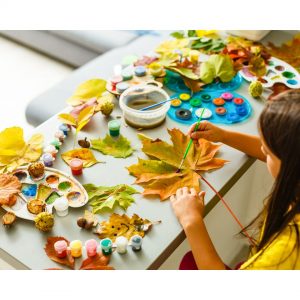
Teaching Your Child Art on a Budget
March 27, 2023Guest post by Heidi Rosenberg
You don’t have to be rich to teach your child about art. With enough creativity, you can teach your child anything you want. There are a lot of talented kids around the world that use their imaginations with crafting, and that helps them stay creative. As a matter of fact, the more you use your imagination and different kinds of tools to create something, the more your body releases dopamine and the more you develop your skills when creating something that you want to have. Just because you don’t have the materials to create art doesn’t mean you shouldn’t be there for your child. Plenty of activities that you can find online that do not require you to buy something extra. There are many crafting ideas that you can get your child to do using things that you can find at home, without spending a fortune. However, spending quality time with your kid and encouraging their creativity and imagination will also help them in the future to be more strategic and come up with a solution, no matter the circumstances.
Creativity is a valuable and important skill for children to develop. It helps them express themselves, think outside the box, and solve problems in innovative ways. Developing your child’s creativity will have many benefits in the future. Art is about expressing oneself and having fun, so don’t worry too much about the supplies or materials. Here are some ways to teach your child art on a budget.
Use Everyday Objects
Everything that surrounds you can be used as a tool to make art. All you need to do as a parent is first to separate what can be used, what is valuable, and what is not. You can find objects at your house and outside. Inside your house, you can use things such as paper towels, and disposable plastic plates as makeshift canvases, egg cartons, and cardboard boxes. Outdoors, you can encourage your child to use found objects such as leaves, sticks, and stones. With all the objects that you can find online, your child can create many things depending on how creative they can get.
Their curiosity to touch and find new things prepares the brain for learning. The Michigan State University Extension offers some suggestions for nurturing curiosity, such as encouraging natural interests by giving them lots of different opportunities to paint. If you see that your child does not like a specific activity, or does not want to create something using available materials, then move on with something of their interest- something that they find much more interesting.
Visit Museums and Art Galleries
Many museums and art galleries offer free admission days or have free exhibitions to which you can take your child. Depending on what your child usually likes, you can also choose a gallery or museum of their interest. Art galleries are very interesting places to visit, and they will teach your child to appreciate art from a young age in a different way. Art in general helps children understand cause and effect, and patterns. It helps them develop their critical thinking when it comes to analyzing and commenting on different art galleries.
Museums, on the other hand, will educate them about history, where they can then create that pattern between stories behind the arts. It will help them understand more about art and their ability to create their own stories based on how they perceive what they see. Museums allow your children to see concrete objects that are significant in history. Such objects comprise in a way the practical part of learning, thus helping children learn actively. This will also teach them about perceptiveness, which is very important in the art world. You can also attend outdoor art festivals, which are often free and offer hands-on art activities for children.
Encourage Creativity Through Play
Making art through play is never boring. Simple activities such as finger painting, molding clay, and drawing with sidewalk chalk can encourage your child to be creative and explore their imagination. You can find different games online that require only paper and colors. For example, the color circles game is an activity that educators usually use to teach young children colors while making it fun. There are numerous games that can be played with simple materials such as paper and colored pencils. You can also use materials such as food coloring, coffee grounds, and salt to make unique art. Different activities not only make them enjoy the time, but they also help children develop their problem-solving skills and encourage motor skills.
Free Online Courses
If you have tried all of these techniques and are looking for new ones but have run out of ideas, a great way to teach your child art on a budget is through free online courses. There are many free online resources available, including videos, tutorials, and printable templates. You can find them everywhere: on YouTube, Facebook, Instagram Reels, Pinterest, and now TikTok. These are some new ways your kid can find techniques to use in order to create art. Some of them involve dipping a sponge in any color and then maneuvering the sponge in the paper to create various shapes and patterns. Consider changing the games or activities that you offer to your child because no matter how attractive a game can be, it gets boring if done for a long time. Changing activities to teach art to your child will help them develop different skills, compared to doing just one activity that would not develop other skills when done for a long time.
By incorporating these simple and cost-effective tips, such as using everyday objects from inside and outside the house, visiting museums and art galleries, and taking free online courses, you can help your child develop their artistic skills and interests without breaking the bank. Remember, every child is unique and may express their creativity in different ways. The key is to encourage their creativity and provide a supportive environment where they feel free to express themselves.
Additional Homeschool Resources
Tips to Help Parents Afford Homeschooling
8 Ways to Encourage Activity in Your Homeschool
Classroom Ideas for Homeschool Families
Latest Posts

While nearly every college and university today is eager to accept homeschooled students into their institutions, homeschooling families need to understand that their student’s application…
Read more >
Guest Post by Gabriel Morse For several years, I sat for long hours every day behind one of those battleship gray desks in a windowless, dull, gray office. The pay was enough to take care…
Read more >
This post is sponsored by Little Monsters Universe. I'm Tina Salmanowitz, an advocate for homeschooling and science education. With over a decade of experience as a science educator (in class…
Read more >

